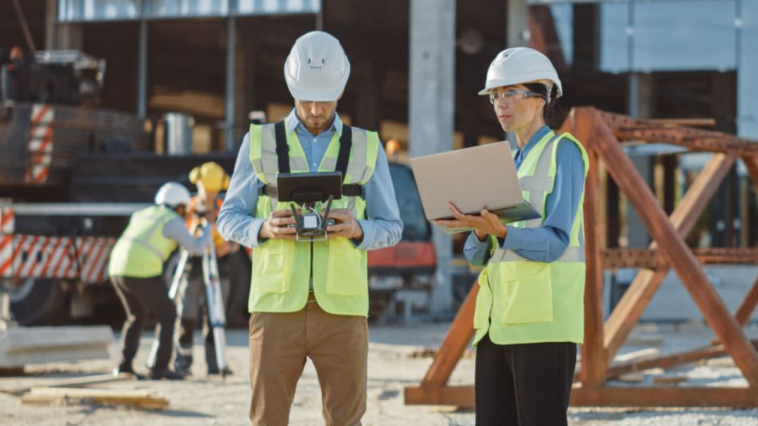Workplace safety is more than due diligence and safe practices. It’s a crucial aspect of employee recruitment, retention, and well-being. Employers can jeopardize their reputations when a work environment isn’t free of harm. Employee morale goes down, workers jump ship, and lawsuits can ensue.
Ensuring the work environment is safe might be a joint responsibility for employees and employers. However, it’s up to organizational leadership to oversee safety programs, train workers, and perform quality checks. Technology, the backbone of most business processes, is also a tool to help leaders and workers improve workplace safety. Whether employees work alone or in teams, learn how tech can reshape safe practices below.
Instructional Software Trains On-the-Spot
Training staff members is a tricky process. You’re likely to have a mix of learning styles within a single group. Some people will grasp information by simply listening to an instructor. Others will need hands-on practice to get the material. And despite everyone’s best intentions, no one will remember it all. Updates to procedures and standard operating practices add another layer of complexity.
By implementing work instruction software, organizations can digitize the process. Instead of relying on paper manuals that employees can fumble through, software distributes safety-related procedures efficiently. For instance, warehouse workers may need to operate machinery according to specific guidelines. It’s one thing to show them once and give them a manual in case they forget. It’s another to have software to guide them in real-time.
As procedures change, instructional software adjusts accordingly. It can also track how employees are implementing safety protocols. Built-in analytics shows where opportunities for further improvements lie. 3D models and videos also cater to various learning styles, making it easier for workers to understand procedures. Sometimes it’s better to see instructions in action than try to make sense of them from words on paper.
Drone Equipment Reduces Hazards
According to OSHA, trip and slip hazards are the second-most common cause of workplace injuries. Falls typically happen because of these hazards, with 20% to 30% of those falls resulting in moderate to severe injuries. Sprains and strains represent some of the potential complications, in addition to concussions and fractures.
By design, some jobs involve reaching inconvenient places like roofs and storage tanks. Others mean performing repetitive movements on surfaces where unforeseen hazards may present problems. Drone equipment cuts down on some risks by conducting surveillance sweeps of areas with probable dangers. Propelled equipment can scope out job sites and keep tabs on worker safety.
Drones and robots can reach locations where it isn’t necessarily safe for humans to go. The equipment can conduct tests and complete inspections without as much human intervention. There could be a job site where it’s not as safe for workers to go into tunnels. Inclement weather may also increase the risk of climbing oil tanks or cell phone towers. Drones and robots could get the most critical jobs done without exposing employees to the threat of injury.
Safety Apps Reveal Opportunities
Managers often rely on employees to tell them when something isn’t safe. Yet, it’s also difficult for leaders to sometimes fully understand the situation if they don’t see it in action. You can tell a supervisor about a problem, but they may not fully realize how precarious it is.
For example, a company operates a fleet of trucks to deliver products to store-based accounts daily. Employees use load bars and straps to secure their loads during transit. The equipment is supposed to keep the product from falling and striking employees while they’re on the road. But what if the equipment becomes a hazard?
Say the company purchased a new fleet with different interior dimensions. Consequently, the load bars that have been in use for years no longer stay secure when trucks encounter road bumps. It’s not just products in boxes falling. Now it’s the load bars with the force to cause serious injuries. Safety apps help monitor and evaluate evolving risks like these while ensuring workplaces comply with government regulations.
IoT Devices Monitor Threats
Threats to workplace safety sometimes come from equipment failures. Wiring problems are an example. Tool malfunctions are another. While companies usually perform maintenance and quality checks on machines, these processes aren’t 100% foolproof. Some problems aren’t immediately detectable from visual inspections.
The human factor also increases the chance of missing or overlooking crucial clues. IoT devices extend the capacity of human-led inspections by monitoring the safety of equipment 24/7. Technology can detect and alert you to problems lurking beneath the surface, reducing future accidents.
IoT technology monitors equipment performance, alerting leaders and employees to invisible threats. Those hazards could be shorts in the wiring that could start a fire. Technology might detect a slow leak, which could cause a major malfunction. When teams know something’s wrong, they’ll avoid using equipment that can seriously injure them. In addition, maintenance staff will know exactly what the problem is and fix it faster.
Improving Workplace Safety With Technology
Unsafe workplaces result in increased injuries, including fatalities. In 2022, there were 4,695 preventable fatal injuries in the workplace. These grave consequences negatively transform workers’ lives, their families’ lives, and work environments. Working longer hours is one of the variables behind the rise in preventable fatalities.
When people put in more time, they’re more likely to become fatigued. Longer hours may also be a symptom of demanding responsibilities or stressful environments. Under these conditions, safety may take a backburner to other priorities.
Leaders can correct some of these deficiencies by utilizing modern technology. Instructional software, drones, safety apps, and IoT devices are a few of the tools organizations should put to good use. Already an essential part of interdependent business processes, technology now has the power to prevent life-changing injuries and safety-related costs.




